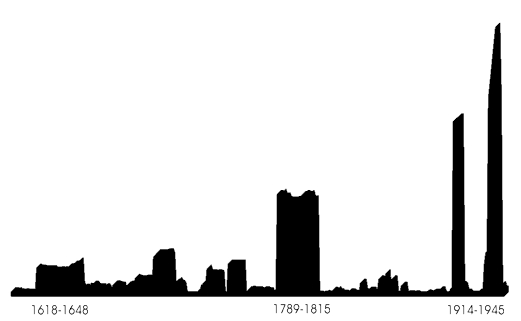
Krus et al (1998)
 | Wars in Europe Krus et al (1998) |
On the stability of states |
| Societies (and not only human societies) are complex dynamic systems. Their members are bound together by forces, but at the same time scared away and expelled by other forces. At equilibrium, both type of forces counterbalance each other, leading to a state of stability. So far for the bare physical and biological facts. |
| Societies usually consist of thousands to millions of members with very similar (if not genetically identical) properties. Their biology stays roughly constant over very long time periods. Since the behavior of a society results from the concerted behaviors of these members, it will be predictable to a high extent - at least in the case of ants and bees. |
| In the case of human societies, the situation is different. Here, social relationships are to a major extent directed by education and learning, and only to a minor extent by pure biology. Therefore, the collective bevavior of human societies is less predictable and subject to gradual changes, from generation to generation. |
| Each human society must have a high interest in the predictability of its collective behaviors. Our economy depends necessarily to some extent on foresight and planning. We eat today what has been harvested last summer and what had been sown in the winter before. And hunger is just one of the needs that can be predicted easily. Other predictions are much more insecure. |
| As long as our needs match our past predictions, everything works out fine and famines will be avoided. But what about more subtle needs? What about our longing for freedom and self-determination? Our need for company and social appreciation? Concerning such more subtle needs, each society exhibits a certain 'atmospheric background' of expicit and tacit conventions. |
| Each nation has its own code of laws. What is forbidden in one country, may be allowed in another. But this is just the visible surface of social conventions. Generally accepted dos and don'ts may differ dramatically across societies, while many of them may be difficult to explain to outsiders. To understand them, you must be born and raised in a particular society. |
| If a particular society pays not enough attention to the personal needs of its members for freedom and self-determination, a rising number of members will revolt against the felt oppression. Minority movements will pop up, and collective activities initiated by the government will be met with suspicion. On the other hand, if collective rules are dismissed alltogether, people will complain the lack of values and directives and open themselves to the tempting promises of eloquent leaders. |
| As long as our cultural memory reaches back, we have seen alternating cycles of centralism with predominating heteronomous behavior and liberalism with predominating autonomous behavior in many societies. If pushed to the extreme, both collective strategies have severe drawbacks and induce strong destabilizing forces. Nevertheless, they represent the exaggerations of those forces, that need delicate counterbalance in any functional and peaceful society. |
| Functional and peaceful societies should be our aim. Although all societies are built on potentially harmful forces, they need exactly these forces to achieve a peaceful and prosperous development. We should be careful that the balance never tilts over to either extreme. How can this be avoided? Eventually not by encouraging the free interplay of forces. This would probably just result in the perpetuation of cycles of peace and violence as experienced during the past millenia. |
| To escape from this dilemma, we need a third element: reason. Only if a majority of the members of a society is open to reasonable arguments, exaggerations in one or the other direction can be avoided. Therefore, investments into general education institutions increase our prospects of a peaceful future. This should be the main purpose of education. Another stabilizing element may be trade (Jackson & Nei 2015). |
| 6/13 < MB 7/13 > 8/13 Society as a complex system |
| Krus DJ, Nelsen EA, Webb JM (1998) Recurrence of war in classical east and west civilizations. Psycholog Rep 83:139-43 Turchin P, Scheidel W (2009) Coin hoards speak of population declines in Ancient Rome. PNAS 106:17276-79 Hsiang SM, Burke M, Miguel E (2013) Quantifying the influence of climate on human conflict. Science 341:1190-1205 Jackson MO, Nei S (2015) Networks of military alliances, wars, and international trade. PNAS 112:15277-84 |